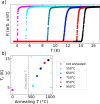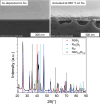Atomic Layer Deposition of Superconductive Niobium Carbonitride Thin Films
- PMID: 40948998
- PMCID: PMC12424125
- DOI: 10.1021/acs.chemmater.5c01456
Atomic Layer Deposition of Superconductive Niobium Carbonitride Thin Films
Abstract
Transition metal carbonitrides (TMCN) are stable materials with excellent catalytic and superconductive properties. Atomic layer deposition (ALD) stands out as the optimal method for the fabrication of these materials, enabling their use in future applications. In this study, we deposit ALD NbC x N y films at 250-450 °C with NbF5 and 1,4-bis-(trimethylsilyl)-1,4-dihydropyrazine on Si, Ru, TiN, and soda lime glass. We analyze the film growth characteristics, composition, and phase. The films show substrate-enhanced growth on Si with a growth per cycle (GPC) of 1.3 Å. Additionally, the films were superconductive as-deposited and had a superconducting critical temperature (T c ) of 14.5 K after annealing at 950 °C. This work expands the range of TMCNs deposited by ALD and demonstrates the applicability of ALD for thin film materials with a high T c .
© 2025 The Authors. Published by American Chemical Society.
Figures












References
-
- Toth, L. E. Transition Metal Carbides and Nitrides; Academic Press, 1971.
-
- Grigore E., Ruset C., Luculescu C.. The Structure and Properties of VN-VCN-VC Coatings Deposited by a High Energy Ion Assisted Magnetron Sputtering Method. Surf. Coat. Technol. 2011;205:S29–S32. doi: 10.1016/j.surfcoat.2011.03.023. - DOI
-
- Giorgi A. L., Szklarz E. G., Storms E. K., Bowman A. L., Matthias B. T.. Effect of Composition on the Superconducting Transition Temperature of Tantalum Carbide and Niobium Carbide. Phys. Rev. 1962;125(3):837–838. doi: 10.1103/PhysRev.125.837. - DOI
-
- Ziegler W. T., Young R. A.. Studies of Compounds for Superconductivity. Phys. Rev. 1953;90(1):115–119. doi: 10.1103/PhysRev.90.115. - DOI
LinkOut - more resources
Full Text Sources
Research Materials
Miscellaneous
